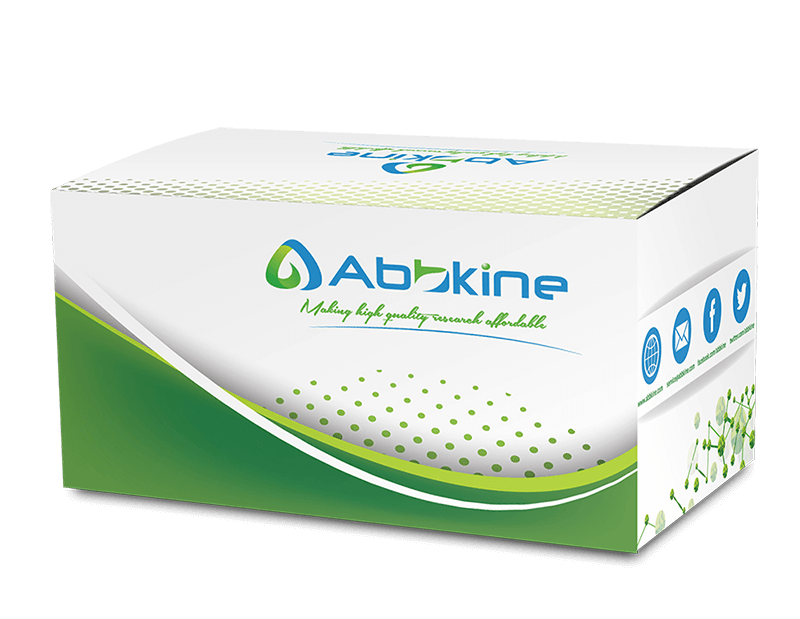

分享产品
His标签小鼠单克隆抗体(5C3),琼脂糖偶联
Agarose Conjugated Anti-His Tag Mouse Monoclonal Antibody (5C3)
产品特点:
选择规格
买2送1活动进行中!购买任意2个规格产品,免费赠送100μL装一支。
活动截止时间:2024年1月31日


买2送1活动进行中!购买任意2个规格产品,免费赠送100μL装一支。
活动截止时间:2024年1月31日
His标签小鼠单克隆抗体(5C3),琼脂糖偶联 (Agarose Conjugated Anti-His Tag Mouse Monoclonal Antibody, clone 5C3) 是一款专为免疫沉淀(IP)实验设计的核心工具,可直接从哺乳动物或细菌裂解液中一步捕获并富集带有多聚组氨酸标签(His-tag)的重组蛋白,无需额外抗体孵育与磁珠/树脂结合步骤。
多聚组氨酸标签(poly-His tag)由连续5–6个组氨酸残基构成,常置于重组蛋白的N端或C端,可借助Ni²⁺/Co²⁺等金属离子螯合作用实现高亲和力结合。本抗体(克隆5C3)特异性识别该标签,并通过化学偶联方式直接固定在琼脂糖树脂上,形成“抗体-琼脂糖”复合物。实验时,只需将细胞或细菌裂解液与树脂混合,即可在温和条件下完成His标签蛋白的免疫沉淀,显著缩短实验流程并降低非特异结合。
广泛用于重组蛋白表达验证、蛋白-蛋白相互作用研究、酶活性分析及下游WB/质谱检测前的His标签蛋白快速富集与纯化,特别适合IP、Co-IP、pull-down等实验场景。

| 中文名称 | His标签小鼠单克隆抗体(5C3),琼脂糖偶联 |
| 英文名称 | Agarose Conjugated Anti-His Tag Mouse Monoclonal Antibody (5C3) |
| 产品货号 | ABT2053 |
| 免疫原 | 合成多肽 |
| 宿主 | 小鼠 |
| 反应性 | 哺乳动物#细菌 |
| 标签 | His |
| 检测类型 | IP |
| 克隆类型 | 单克隆 |
| 亚型 | 小鼠IgG1 |
| 纯化工艺 | 通过使用特异性免疫原的亲和层析,从小鼠腹水中纯化抗体。 |
| 偶联物 | 琼脂糖树脂 |
| 产品形式 | 液体形式 |
| 储存缓冲液 | 50% gel slurry suspended in PBS, pH 7.4, containing 0.02% Sodium Azide. |
| 保存建议 | 从发货之日起,4°C可稳定保存一年。避免反复冻融或者涡旋。 |
| 运输条件 | 冰袋运输(蓝冰) |
| 警告 | 本文列出的产品仅供研究使用,不适用于人类或临床诊断。我们产品所推荐应用,不是建议使用我们的产品去违反任何专利或许可证。对于使用本产品可能发生的专利侵权或其他违规行为,我们不承担任何责任。 |
Note: Per 500 μL of protein sample add 20 μL Magnetic Beads. Perform the following procedures, according to add 20 μL Magnetic Beads.
Note:Note: a) For a few samples, due to differences in target proteins, the binding of His-Tag and Anti-His antibody is very strong, and the effect of Acid elution and Competitive elution of peptide may be poor. Therefore, SDS-PAGE Loading Buffer denaturation elution method is recommended as a priority; b) Due to the difference of target protein, the elution efficiency of acid elution method also varies to some extent. If the requirement of elution efficiency is high, the pH value of acidic eluent can be adjusted appropriately between 2.5-3.1, and the pH value or quantity of corresponding neutralizing solution should be adjusted appropriately. For example, 100 μL Acid Elution Buffer (0.1 M Glycine-HCl, pH 2.8) and 15 μL Neutralizing Buffer (1 M Tris-HCl, pH 8.5).
Note: a) For a few samples, due to differences in target proteins, the binding of His-Tag and Anti-His antibody is very strong, and the effect of Acid elution and Competitive elution of peptide may be poor. Therefore, SDS-PAGE Loading Buffer denaturation elution method is recommended as a priority; b) Due to the difference of target protein, the elution efficiency of acid elution method also varies to some extent. If the requirement of elution efficiency is high, the pH value of acidic eluent can be adjusted appropriately between 2.5-3.1, and the pH value or quantity of corresponding neutralizing solution should be adjusted appropriately. For example, 100 μL Acid Elution Buffer (0.1 M Glycine-HCl, pH 2.8) and 15 μL Neutralizing Buffer (1 M Tris-HCl, pH 8.5).
Note:| Catalog No. | Product Name |
|---|---|
| ABT2014 | Magnetic Beads Conjugated Anti-DDDDK Tag Mouse Monoclonal Antibody (1B10) |
| ABT2024 | Magnetic Beads Conjugated Anti-GFP Tag Mouse Monoclonal Antibody (3D3) |
| ABT2044 | Magnetic Beads Conjugated Anti-HA Tag Mouse Monoclonal Antibody (4F6) |
| ABT2064 | Magnetic Beads Conjugated Anti-Myc Tag Mouse Monoclonal Antibody (2D5) |
| ABT2174 | Magnetic Beads Conjugated Anti-V5 Tag Mouse Monoclonal Antibody (11D5) |
The reagent is only used in the field of scientific research, not suitable for clinical diagnosis or other purposes.
A: 荧光western blotting的结果需要特殊的仪器检测,即一种荧光成像仪器。即运用荧光成像仪可以对荧光WB的实验结果进行成像和数据采集分析。如果希望应用荧光成像做WB,建议选用Abbkine DyLight 680和DyLight 800荧光二抗,货号分别为A23710、A23720、A23910、A23920。
A: 0.5 mg/ml。
A: 甘油是可以减慢抗体分子之间的碰撞,起到抗体保护剂的作用。
杂志名称: Cell Death & Differentiation | 作者: Teng, Peng, et al.
IF: 12 | 发表时间: 2024
我们的技术团队为您提供全方位的产品支持服务
根据您的研究目标,提供个性化的实验设计方案
经验丰富的技术专家协助您解决实验中遇到的问题
7x24小时在线技术支持,随时为您答疑解惑
提供免费样品试用,让您先试后买更放心
